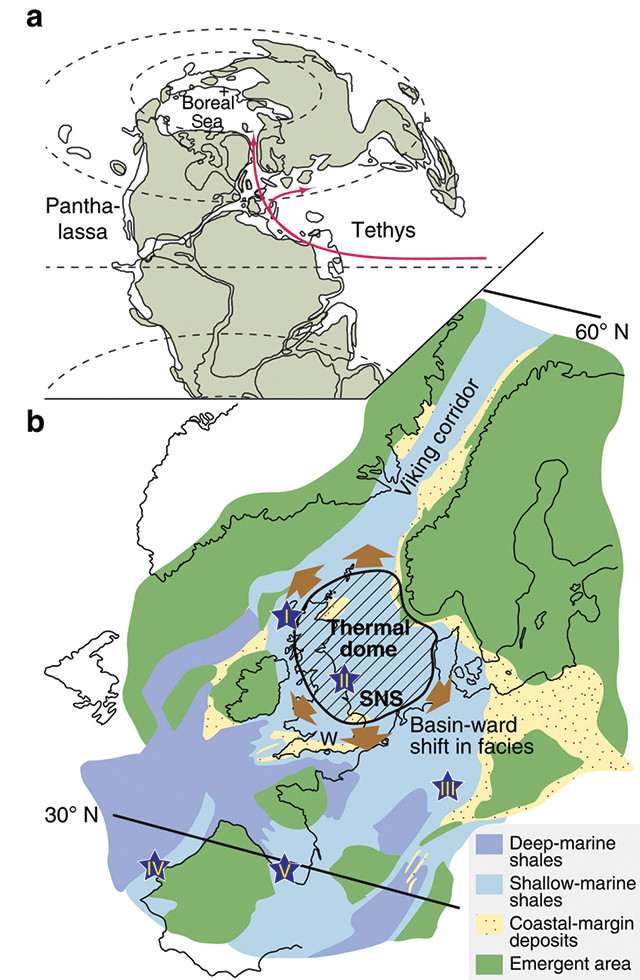
by Lauren Milideo Wednesday, March 30, 2016

The Laurasian Seaway (a) connected the Boreal Sea to the Tethys Ocean to the south during the Jurassic. Uplift of the North Sea Dome (b) beginning in the Early Jurassic might have blocked the northward flow of warm Tethyan waters through the seaway, causing an abrupt cooling event about 174 million years ago. Credit: Korte et al., Nature Communications, December 2015, CC BY 4.0.
The climate of the Jurassic, long envisioned as ubiquitously warm from the equator to the poles, was actually more dynamic, sometimes cooling dramatically, according to a new study. The research joined isotopic and sedimentological data to suggest that an abrupt cooling event occurred in the midlatitudes early in the Middle Jurassic as a result of changing ocean currents associated with a feature known as the North Sea Dome.
Exploration of Jurassic climate fluctuations has focused mainly on warming events and their causes, yet similar insights regarding colder periods have been lacking, says Christoph Korte, a paleontologist at the University of Copenhagen in Denmark and lead author of the new study in Nature Communications. Korte says he previously noticed fluctuations in published Jurassic isotope datasets — including a 1999 compilation he had co-authored that included data he had collected — suggesting that a substantial temperature shift likely occurred as the Early Jurassic shifted to the Middle Jurassic about 174 million years ago.
For the new study, Korte and his colleagues assembled oxygen and carbon isotopic datasets — including both original and previously published data — from biostratigraphically well-constrained fossils of belemnites, brachiopods and bivalves found in sedimentary basins in England, Germany, Portugal, Scotland and Spain. The fossils spanned portions of the Early and Middle Jurassic, dating to between 191 million and 168 million years ago. And the sites where they were collected comprised a transect of the Jurassic Laurasian Seaway, which extended from the chilly Boreal Sea south to the warmer Tethys Ocean during the breakup of the supercontinent Pangea.
The team found that the oxygen isotopes in the dataset, which reflect the paleotemperature of the seawater in which the organisms’ calcite shells originally grew, revealed a sudden cooling episode starting just after the Early-to-Middle Jurassic transition, about 174 million years ago. “This was an extreme shift of 10 degrees Celsius,” Korte says. And as some organisms cease calcification in cold conditions, the isotopes “might not have recorded the coolest temperatures in the water in that area at that time,” he adds, suggesting that 10 degrees is likely the minimum amount of cooling that occurred.
Meanwhile, the carbon isotopes in the dataset, which reflect larger-scale shifts in carbon dioxide in the ocean-atmosphere system, showed only minor fluctuations at the time of the oxygen isotope shift, not abrupt cs. The small fluctuations in the carbon isotope data can be explained by small changes in biological productivity, “but in general there is no correlation over a long time span” between the two isotopic datasets, he says. “It looks like we have an extreme fluctuation in climate, which we cannot relate to changes in carbon dioxide.” So, Korte says, his team went looking for another explanation.
Published sedimentological and stratigraphic data indicating a regional drop in sea level and an erosional unconformity amid parts of the former Laurasian Seaway had previously been linked to uplift of the North Sea Dome, which occurred through the Jurassic as rising magma uplifted the local lithosphere. Based on these records and the close temporal correlation of the uplift with the newly recognized oxygen isotope shift, Korte’s team concluded that the uplift blocked the northbound marine current through the seaway, and with it, the south-to-north thermal flow. This allowed cooler conditions to extend south, Korte says, creating “boreal temperatures [down into] the middle of Europe.”
In deep-time studies like this, “there is always some limitation on how precise the conclusions can be” because of the use of imperfect paleotemperature proxies, says sedimentologist Stéphane Bodin of Aarhus University in Denmark, who wasn’t involved in the study. Extinct belemnites, such as those used in the new study, lack modern relatives that can be studied to confirm that the fossils record paleotemperatures accurately, Bodin says. However, he notes that the consistency of the belemnite isotopic signal with that from the brachiopods, which do have modern relatives and are known to faithfully record paleotemperatures, strengthens the conclusions.
It’s also possible that the temperature changes observed in this study “are just regional, and not global,” Bodin says, so useful next steps would be to conduct a similar study elsewhere to see if larger-scale cooling occurred, and to try using different paleotemperature proxies on the same fossils to see if the signals are consistent.
The study of a cooling event is important, Bodin says. Past warming events are studied to help understand current global warming, but “we also need to understand what drives cooling events,” he says, because a comprehensive understanding of climate must include causes of both warming and cooling.
© 2008-2021. All rights reserved. Any copying, redistribution or retransmission of any of the contents of this service without the expressed written permission of the American Geosciences Institute is expressly prohibited. Click here for all copyright requests.